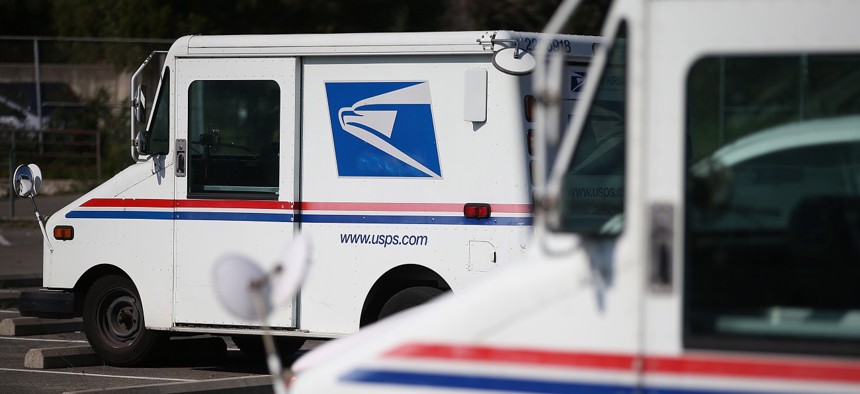USPS Ramps Up Electric Vehicles to Half of Its Initial Contract Order
With a new network and cash windfall, the Postal Service is going more electric—including with off-the-shelf options.
Half of the vehicles the U.S. Postal Service will purchase from the initial order of its controversial agreement with a defense contractor will be electric, the agency announced on Wednesday, marking a significant increase from its previous promises.
USPS initially said it would make just 10% of its Next Generation Delivery Vehicles purchases electric, but financial relief delivered from Congress and changes to its network have made the higher rate possible. In addition to its contract with Oshkosh Defense, worth at least $3 billion for the first order of 50,000 vehicles, the Postal Service said it will purchase 34,500 commercial, off-the-shelf vehicles. It will buy as many EVs as are commercially available and “satisfy operation needs,” and all told expects 40% of the nearly 85,000 vehicles to be electric.
Postal management has faced significant pushback from the White House, lawmakers and environmental groups for its original plan to buy a much smaller share of EVs, leading to the introduction of legislation and the filing of lawsuits. When USPS unveiled its initial order in March, it made the surprise announcement it was increasing the proportion of EVs to 20%. Still, critics said the agency was not going nearly far enough in moving away from a gas-powered fleet. USPS plans to eventually replace 165,000 trucks and vans in its aging fleet through its NGDV contract, though it has so committed to buying only 50,000 of those from Oshkosh.
The new, gas-powered trucks are only expected to increase the fuel economy from 8.2 miles per gallon in the current iteration to just 8.6. Postal officials have noted current vehicles do not have air conditioning, and the vehicles will get 14.7 miles per gallon when the cool air is not running. The new vehicles will also have more cargo space and require fewer trips, USPS has said.
The Biden administration has publicly pushed USPS to conduct a new environmental impact study to justify its plan to buy primarily gas-powered vehicles, saying its original study was insufficient and rested upon faulty assumptions. After initially declining to do so and saying a new review was unnecessary, postal management in June said it would supplement its study and potentially expand the number of EVs it planned to buy. That announcement followed President Biden in April signing into law the first significant postal reform law in 15 years, which is expected to save a combined $107 billion for USPS by eliminating existing debt and taking future liabilities off of its books. The agency reported a profit of $58 billion in the first half of fiscal 2022 as a result of that financial relief.
Postal management pointed to its plan to consolidate many of its processing facilities into mega-centers in justifying why more EVs make sense operationally. The revised network, part of Postmaster General Louis DeJoy’s 10-year break-even plan, will lead to fewer trips between facilities, more optimized routes and charging stations consolidated at fewer locations. USPS vowed to conduct additional impact studies before each round of vehicle purchases, saying it will carry out those evaluations frequently so it can quickly adapt to changes in technology, market conditions and its own operational strategy. It did not commit to buying more vehicles through its Oshkosh contract, saying instead that it will weigh tapping into it versus simply buying off-the-shelf options.
After finding earlier this year USPS can viably support about 99% of its routes every day using all electric vehicles, the agency’s inspector general announced it would further investigate the Oshkosh contract and whether postal management has met its obligations for environmental reviews.
Rep. Carolyn Maloney, D-N.Y., who chairs the House Oversight and Reform Committee and has led the charge pushing USPS to go more electric, said she would not give up fighting the agency to go further.
“Our Postal Service fleet of the future must be clean, affordable, and electric,” Maloney said. “This is the fleet that the American people deserve. I am pleased by this progress, but I will continue to fight for the Postal Service fleet to fully transition to electric vehicles.”
The new NGDVs are expected to be on the road in late 2023. DeJoy previously said he was “not even thinking about” the makeup of future vehicle procurements, noting the original 50,000 order was not expected to be complete until 2027. Citing the “critical and immediate need” to speed up the replacement of its existing fleet, however, management is now looking to speed up that timeline with off-the-shelf vehicles.






